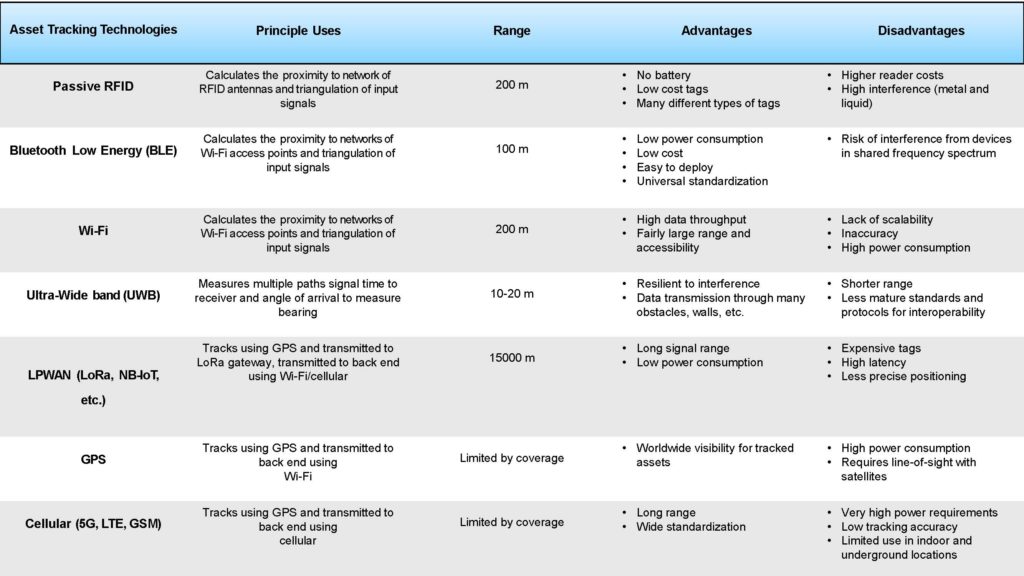Many new asset tracking technologies have emerged over the years. Among these are BLE beacons and tags, RFID, and barcodes to name a few. Each of these technologies has its advantages and disadvantages depending on the use case. In this blog, we’ll give a quick overview of some of these asset tracking technologies, the advantages and disadvantages of each and as well as a comparison chart to summarize these technologies.
RFID
Radio Frequency Identification or RFID uses radio waves to identify people or objects. Usually, there’s a device that reads the information contained in a wireless device or “tag” from a distance without making any physical contact or requiring a line of sight. Tagged items equipped with RFID tags allow users to automatically identify and track assets. There are two types of RFID, passive and active.
Passive RFID uses high-power readers that send out a low-frequency, high-power RF signal to battery-free tags. The tag will then transmit a coded message back to the reader at a different frequency. The cost of a passive RFID tag is really inexpensive, usually around $0.10 to $0.60 per tag and is battery-free which makes them quite popular. Passive RFIDs are typically used in healthcare and retail.
Active RFID use battery-powered tags that continuously broadcast their own signal. They are often used to accurately track the real-time location of assets. Active tags provide a much longer read range than passive tags, but they are also much more expensive, ranging from $5 to $20 per tag. Because active RFID tags are powered by batteries typically lasting 3-5 years, they will need to be replaced which adds additional costs to the end-user. Active RFID tags are sometimes used as “beacons” to track the real-time location of assets such as oil, gas and construction.
Barcodes
The use of barcodes for asset tracking dates back to the 1950s when they first emerged but only became commercially successful in the 1970s. Barcodes for asset tracking have helped businesses worldwide improve data accuracy and speed up inventory management. Over the years, new techniques have emerged such as invisible and QR codes but the concept has remained largely the same. One of the biggest advantages of barcodes is their low cost. They are also very small and lightweight which makes them easy to use and manage. Unfortunately, the use of barcodes for asset tracking may not be the ideal solution for every use case. For example, barcodes don’t inherently show location, let alone show any real-time status. What they do show is identification at the last recorded scan. Essentially this requires scanning to be recorded with some form of location data to actually know where the assets are.
Ultra-Wide Band (UWB)
Like Bluetooth and Wi-Fi, ultra-wideband (UWB) is a short-range, wireless communication protocol that operates through radio waves. But unlike other wireless technologies, it operates at very high frequencies, a broad spectrum of GHz frequencies. Think of UWB as a continuously scanning radar that can find an object, discover its location and communicate with it. To determine the location precisely in real-time, UWB typically utilizes techniques such as Angle of Arrival (AoA), Time of Flight (ToF), Time-Distance-of-Arrival (TDoA) and other measurement methods. UWB is ideal for tracking and location-heavy industry environments and is ideal for tracking high-value assets and/or situations where security and safety are of concern, such as healthcare. However, UWB has not yet achieved market acceptance because of its lack of interoperability. Also, UWB does require more power than other wireless technologies.
Bluetooth Low Energy (BLE)
Bluetooth technology is one of the most common technologies for asset application applications. Its low cost and low power consumption give it a competitive edge over other wireless technologies like Wi-Fi. Many BLE solutions being used can incorporate Bluetooth enabled devices such as smartphones and/or tablets which helps to simplify implementation and deployment. Bluetooth technology is ideal for any industry including IIoT, Smart Campus, Smart City and Digital Health. For example, shopping malls, airports and hospitals use BLE to gather location data as well as for personnel and asset tracking applications.
Wi-Fi
Like BLE, Wi-Fi primarily uses RSSI techniques to locate and track assets. This includes using historical RSSI in a method called fingerprinting, which helps location systems perform with more reliability. However, this does add additional expenses concerning preparation and transmitter density. As with BLE and UWB, some Wi-Fi solutions can also use AoA and ToF measurements, but this could also involve complex preparation, setup and calibration.
Some disadvantages of using Wi-Fi for asset tracking are inaccuracy and unreliability, especially when using RSSI. Not only is there the possibility of congestion with existing Wi-Fi networks, but the presence of moving objects and/or other obstacles can hinder precise positioning.
In sum, each of these technologies has its advantages and disadvantages. The key to choosing the right wireless technology depends on several factors such as the physical environment, use case, desire accuracy as well as overall costs to name a few. For a summary of each asset tracking technology, please see the summary table below.








